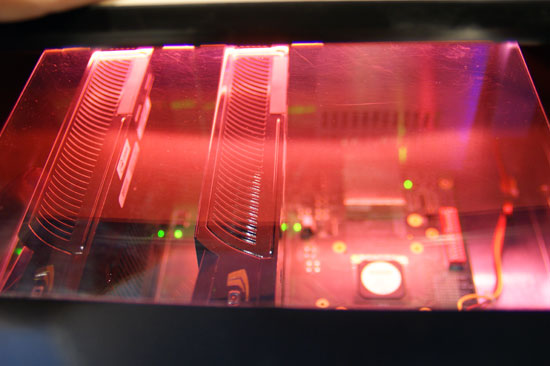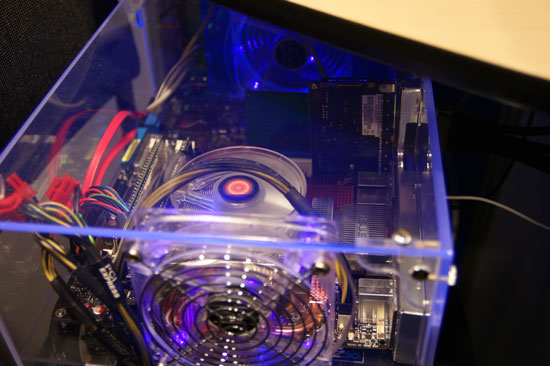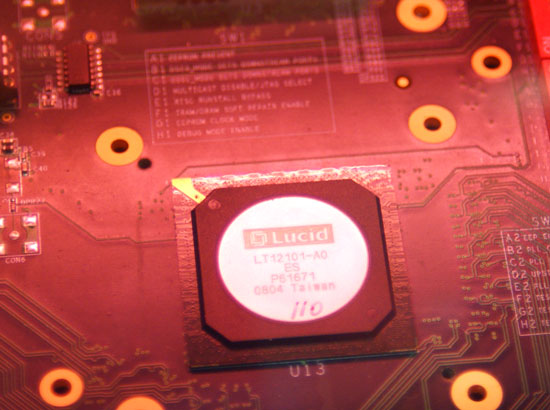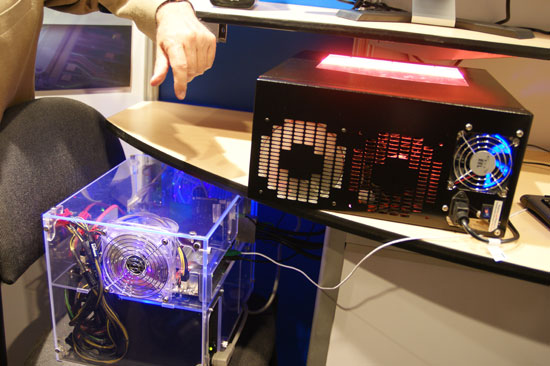Lucid Hydra 100 - Enabling SLI/CrossFire on Any Platform
by Derek Wilson on August 20, 2008 12:00 AM EST- Posted in
- Trade Shows
Well the title is a little misleading. It isn't enabling SLI or CrossFire: it is making them irrelevant and useless by replacing them with a better GPU independent multi-GPU solution. Lucid is a company with lots of funding from Intel, and they are a chip designer that is gearing up to sell hardware that enables truly scalable multi-GPU rendering.

While graphics is completely scalable and there are native solutions to extract near linear performance gains in every case, NVIDIA and AMD have opted not to go down this path yet. It is quite difficult, as it involves the sharing of resources and more fine grained distribution of the workload. SLI and CrossFire are bandaid solutions that don't scale well past 3 GPUs. Their very course grained load balancing and the tricks that must be done to handle certain rendering techniques really hobbles the inherent parallelism of graphics.

Lucid, with their Hydra Engine and the Hydra 100 chip, are going in a different direction. With a background in large data set analysis, these guy are capable of intercepting the DirectX or OpenGL command stream before it hits the GPU, analyzing the data, and dividing up scene at an object level. Rather than rendering alternating frames, or screens split on the horizontal, this part is capable of load balancing things like groups of triangles that are associated with a single group of textures and sending these tasks to whatever GPU it makes the most sense to render on. The scene is composited after all GPUs finish rendering their parts and send the data back to the Lucid chip.

The tasks that they load balance are even dynamically defined, and they haven't gone into a lot of detail with us at this point. But we have another meeting scheduled with them today. So we'll see what happens there.

These guys say they always get near linear scaling regardless of application, and that the scaling is not limited to a number of GPUs. Meaning that 4x GPUs would actually see nearly 4x scaling. Or that 10 GPUs would see 10x scaling. The implications, if this actually works as advertised are insane.

So why is Intel interested in this? Well, they could offer a platform solution through motherboards with this chip on them that delivers better multi-GPU scaling than either NVIDIA or AMD are capable of offering natively on their own platforms. With the issues in getting NVIDIA SLI on Intel systems, this will really be a slap in the face for them.

We will definitely bring you more when we know it. At this point it seems like a great idea, but the theory doesn't always line up with the execution. If they pull of what they say they can it will revolutionize multi-GPU. We'll see what happens.










33 Comments
View All Comments
Goty - Wednesday, August 20, 2008 - link
Course =/= CoarseTonyB - Wednesday, August 20, 2008 - link
need benchmarks on Crysis on a quad 280 setup.hooflung - Wednesday, August 20, 2008 - link
There is next to no latency according to Lucid. The problem is that Vista doesn't allow 2 graphics card drivers to work at one time so you cannot mix ATI and Nvidia cards in a hydra setup until microsoft fixes that, if possible.The catch is how much is the hydra going to run. If you look on Dailytech's preview you will see how the graphics are rendered. It splits up the scene before it ever hits the graphics driver, thus, there is no latency that AFR or bandwidth issues.
Ananke - Wednesday, August 20, 2008 - link
Lucid chip recognizes the instruction pattern, i.e. rendering triangles, textures etc. What about recognizing CUDA or other computational applications designed to run on graphics? If it can't split those instructions effectively, than the Nvidia idea of heavy computations done on multiple GPUs is compromized, and this is exactly what Intel wants :), thus they fund the research in Lucid. Intel needs to wash away competition in heavy computing and eventually make dominant market space for Larabee, i.e. multiple x86 Intel chips.UnlimitedInternets36 - Friday, August 22, 2008 - link
Given Intel's orientation with Larrabee being just compute in HW and DX&GL being implemented in API. I think they have this in mind. Gaming graphics are always a useful display example, but you can bet they want GPGPU sales as well.legoman666 - Wednesday, August 20, 2008 - link
There has to be some catch. There's no way ATI or nVidia with their respective R&D budgets wouldn't have implemented this if it works as promised. Both companies I'm sure have put many times more money into researching this sort of thing than this small company that no one has heard of.Dark Legion - Wednesday, August 20, 2008 - link
Yes, maybe more money than a small company that nobody has heard of (until now), but not a company that has "loads of funding from Intel" (3rd sentence of the article, come on)Rev1 - Wednesday, August 20, 2008 - link
"Lucid is a company with lots of funding from Intel,"Which means they have plenty of money for R&D.
nycromes - Wednesday, August 20, 2008 - link
how much spent on R&D has nothing to do with it. Large corporations like NVIDIA/ATI frequently have trouble thinking outside of the box (in other words, how can we get people to buy 2 of our cards).I assume you are talking about the scalability factor of this product vs current crossfire/SLI configurations. Both ATI/NVIDIA are unlikely to think of placing something essentially between the Graphics cards and the rest of the computer. Lots of new ideas are thought of by the little guys, if their idea is good enough/plausable they can overnight become a major player in their fields. The best thing about this for all the companies involved? The vid card manufacturers still sell their cards and Lucid's not going to have any real competition if this plays out and is true. I am skeptical, but I don't think that NVIDIA or ATI would have thought this far outside of the box. Who knows, only time will tell.
IKeelU - Wednesday, August 20, 2008 - link
I wouldn't be surprised to hear that ATI/Nvidia actually have the expertise to do this, but still prefer Crossfire/SLI because it locks consumers into their format. But perhaps ATI is actually performing similar logic on their multi-GPU boards (their dual-GPU boards do perform quite well after all), and it was only a matter of time before technology migrated to one of AMD's platforms.This is probably a stupid question, but will this chip be designed to work with a specific API? For example, will there be a "hydra" chip for every new directX release?